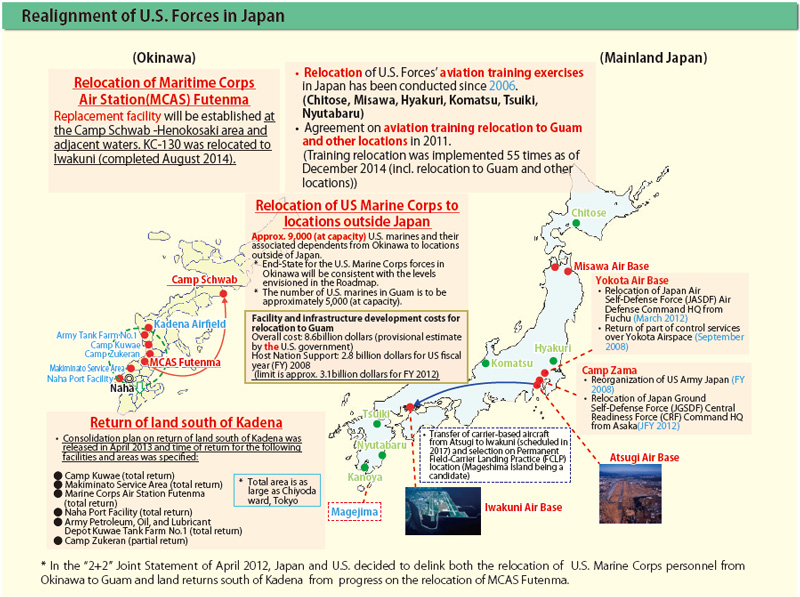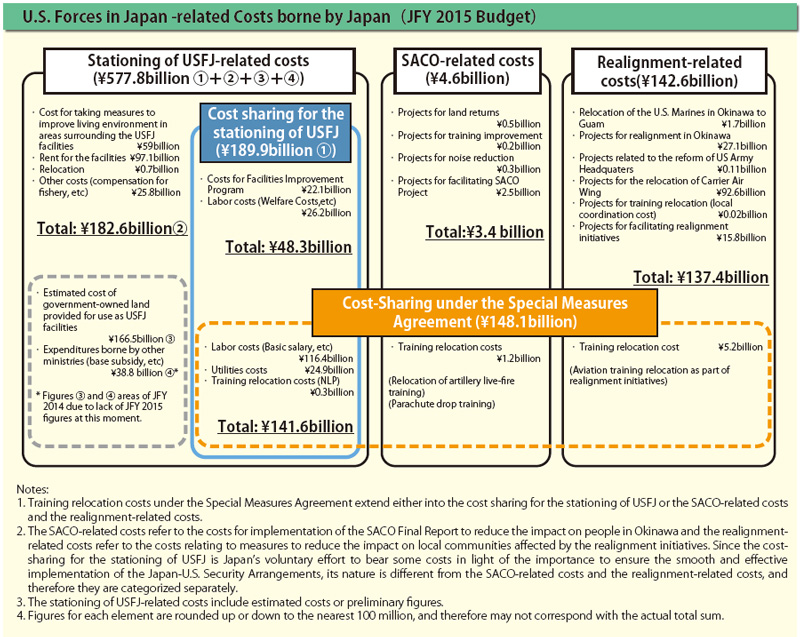Diplomatic Bluebook 2015
Chapter 3
Japan’s Foreign Policy to Promote National and Worldwide Interests
2.The Japan–U.S. Security Arrangements
(1) Overview of Japan–U.S. Security Relationship
Under the security environment surrounding Japan which is becoming increasingly severe, it is indispensable to strengthen the Japan–U.S. Security Arrangements and to enhance the deterrence of the Japan–U.S. Alliance not only to the security of Japan but also to the peace and stability of the Asia-Pacific region. Based on the robust bilateral relationship confirmed through such meetings as the Japan U.S. Summit Meeting in April 2014, Japan and the U.S. are expanding and strengthening cooperation in a wide range of areas, including ballistic missile defense, cyberspace, and space, as well as by revising the Guidelines for Japan–U.S. Defense Cooperation. Japan and the U.S. have been working closely on the realignment of U.S. Forces in Japan (USFJ), including the relocation of Marine Corps Air Station (MCAS) Futenma and the relocation of U.S. Marine Corps in Okinawa to Guam, in order to mitigate impact on local communities, including Okinawa, while maintaining the deterrence of the USFJ.
 Parliamentary Vice-Minister for Foreign Affairs Takashi Uto holds talks with JPAC Commanding Officer Kelly McKeague (January 15, Honolulu)
Parliamentary Vice-Minister for Foreign Affairs Takashi Uto holds talks with JPAC Commanding Officer Kelly McKeague (January 15, Honolulu)
(2) Japan–U.S. Security and Defense Cooperation in Various Fields
A. Revision of the Guidelines for Japan–U.S. Defense Cooperation (the “Guidelines”)
At the October 2013 meeting of the Japan–U.S. Security Consultative Committee (the “2+2”), the two governments agreed to initiate a task of revising the Guidelines. Accordingly, the Interim Report on the Revision of the Guidelines was issued in October 2014, with a view to promoting understanding of the revision both domestically and internationally. In the “2+2” Joint Statement issued in December, the two governments recognized the significance of ensuring consistency between the revision of the Guidelines and Japan’s legislative process and the importance of ensuring the robust content of the revised Guidelines. In addition, the two governemtns decided to deepen the discussions further to work toward finalizing the revision of the Guidelines during the first half of 2015, taking into account the progress of Japan’s legislative process.
B. Ballistic Missile Defense (BMD)
Japan has been making steady efforts to develop the BMD system while continuing cooperation with the U.S., including the steady implementation of joint development of the Standard Missile 3 (SM-3) Block IIA since 2006. In December 2014, the second AN/TPY-2 radar (X-band radar) was deployed in the U.S. Kyogamisaki Communication Site (Kyoto Prefecture).
C. Cyberspace
The two countries held the second Japan–U.S. Cyber Dialogue in Washington, D.C. in April 2014. Based on the necessity for a whole-of-government cooperation between Japan and the U.S., participants from both sides had a follow-up discussion on the outcome of the first Japan-U.S. Cyber Dialogue held in May 2013. Participants also discussed a wide range of areas for Japan–U.S. cooperation in cyberspace, including the protection of critical infrastructure, capacity-building, and cybercrime, in addition to the discussion focusing on the security aspect.
D. Space
At meetings such as the Space Security Dialogue in February and the Second Meeting of the Japan–U.S. Comprehensive Dialogue on Space in May, Japan and the U.S. discussed a wide range of cooperation on space, including in the area of security. In May, Japan and the U.S. decided to cooperate on exchanging information in the field of Space Situational Awareness (SSA), in which Japan will provide the U.S. with information concerning the trajectories of objects in space. This makes it possible for Japan and the U.S. to share SSA information with each other, building on the arrangements put in place for the U.S. to provide information to Japan under the Exchange of Notes concerning SSA Services and Information Sharing (May 2013). The two countries are undertaking further space security cooperation, such as efforts to ensure resiliency of space assets.
E. Trilateral Cooperation
Japan and the U.S. place importance on security and defense cooperation with allies and partners in the Asia-Pacific region. In particular, the two countries are steadily promoting trilateral cooperation with Australia, the ROK, and India. At the Japan–U.S.–ROK Trilateral Summit Meeting in March and the Japan–U.S. Australia Trilateral Summit Meeting in November, the leaders affirmed that these trilateral dialogues promote the shared security interests of Japan and the U.S. and that it will contribute to improving the security environment in the Asia-Pacific region.
F. Information Security
Information security plays a crucial role in advancing cooperation within the context of the Alliance. The two countries are discussing ways to further improve information security systems, including introducing government-wide security clearances and enhancing counterintelligence measures (designed to prevent information leaks through espionage activities).
G. Maritime Security
In forums such as the ASEAN Regional Forum (ARF) and the East Asia Summit (EAS), Japan and the U.S. stress the importance of solving maritime issues in accordance with international law. At the summit meeting in April, Japan and the U.S., as maritime nations with global trade networks that depend on open seas, underscored the importance of maintaining a maritime order based upon respect for international law, including the freedom of navigation and overflight.
(3) Realignment of U.S. Forces in Japan
In 2006, Japan and the U.S. announced Japan U.S. Roadmap for Realignment Implementation (the Roadmap). Following the subsequent review of the realignment plan, the two countries supplemented the Roadmap with the “2+2” joint statements of 2010 and 2011. Furthermore, in the “2+2” Joint Statement of 2012, Japan and the U.S. decided to adjust the plan for realignment of U.S. Forces set out in the Roadmap and to delink both the relocation of U.S. Marine Corps from Okinawa to Guam and land returns south of Kadena Air Base from progress on the relocation of MCAS Futenma.
Amid this situation, in the Japan–U.S. Joint Statement issued during the visit of President Obama to Japan in April 2014, the two countries confirmed that they were making sustained progress towards realizing a geographically distributed, operationally resilient and politically sustainable U.S. Forces posture in the Asia-Pacific, including the development of Guam as a strategic hub. Moreover, in this Joint Statement, the two countries stated that the early relocation of MCAS Futenma to Camp Schwab and consolidation of bases in Okinawa would ensure a long-term sustainable presence for U.S. Forces, and in this context, they reaffirmed their commitment to reducing the impact of U.S. Forces on Okinawa.
In the Japan–U.S. Joint Press Release in October 2014, the two countries reaffirmed that the plan to construct the Futenma Replacement Facility (FRF) at the Camp Schwab-Henokosaki area and adjacent waters is the only solution to avoid the continued use of MCAS Futenma. Moreover, they reconfirmed the importance of land returns south of Kadena Air Base based on the Roadmap and April 2013 Consolidation Plan and stressed their determination to continue efforts towards their implementation. As well as continuing to strive to reduce the impact on Okinawa, Japan will devote all the efforts to realize the return of MCAS Futenma as early as possible, steadily moving forward with the relocation to Henoko in accordance with its laws and regulations.
Furthermore, in the joint press release, the two countries welcomed other achievements since the October 2013 “2+2” Joint Statement regarding realignment and impact mitigation. Specifically, the following were achieved in 2014.

In July and August, all 15 KC-130 aircraft were relocated from MCAS Futenma to MCAS Iwakuni. Having been an outstanding issue for 18 years, since the release of the final report by the Special Action Committee on Okinawa (SACO) in 1996, this marked the fruition of efforts by both Japan and the U.S. to reduce the impact on Okinawa. In March, the Japan–U.S. Joint Committee reached an agreement on the partial lifting on the use of restrictions for a portion of the Hotel-Hotel training area located off the east coast of Okinawa. Moreover, the same month, the Joint Committee reached an agreement on adding air-to-ground training at the Misawa Air-to-Ground Gunnery and Bombing Range in the framework of the expansion of the relocation of U.S. Forces training. The relocation of training under this agreement is characterized as a concrete measure that substantially contributes to reducing the impact on Okinawa as it will reduce noise surrounding the Kadena Air Base. Furthermore, between May and October, two Global Hawk aircrafts based in Guam were deployed to Misawa Air Base on a temporary rotation, based on the October 2013 “2+2” Joint Statement. The deployment of these aircraft helps to maintain and strengthen the deterrence of U.S. Forces in the Asia-Pacific region, as well as contributes to the security of Japan and the stability of the region.
(4) Host Nation Support (HNS)
In light of the importance of ensuring the smooth and effective operation of the Japan–U.S. security arrangements, Japan bears expenditures including the land rent for the USFJ’s facilities and areas and the Facilities Improvement Program (FIP) funding within the scope of the Status of Forces Agreement. In addition to this, by concluding the Special Measures Agreement, Japan also bears labor costs, utilities costs, and training relocation costs for USFJ.

(5) Various Issues Related to the Presence of U.S. Forces in Japan
To ensure the smooth and effective operation of the Japan–U.S. security arrangements and the stable presence of U.S. Forces in Japan as the linchpin of these arrangements, it is important to reduce the impact of U.S. Forces activities on residents living in the vicinity and to gain their understanding and support regarding the presence of U.S. Forces. In particular, the importance of promoting reduction of the impact on Okinawa, where U.S. Forces facilities and areas are concentrated, has been confirmed mutually by Japan and the U.S. on numerous occasions, including the Japan–U.S. summits, the “2+2” meetings, and the Japan–U.S. Foreign ministerial meetings.
While continuing to work towards the realignment of U.S. Forces in Japan, Japan has been making its utmost efforts to make improvements in specific issues in light of the requests of local communities such as preventing incidents and accidents involving U.S. Forces, reducing the noise impact by U.S. Forces aircraft, and dealing with environmental issues at U.S. Forces facilities and areas in Japan.
As the current Japan–U.S. Status of Forces Agreement (SOFA) does not include specific provisions on environment in December 2013, Japan and the U.S. concurred on launching bilateral consultations towards a bilateral agreement that would supplement SOFA in the field of environment. Nine rounds of negotiations at director-level were held since February 2014, and the two countries announced in the Japan-U.S. Joint Press Release in October 2014 that substantial agreement has been achieved on an Agreement on Cooperation in the Fields of Environmental Stewardship Relating to the United States Armed Forces in Japan, which would supplement SOFA. This Supplementary Agreement would explicitly include provisions that stipulate that (1) the U.S. Government issues and maintains environmental governing standards that adopt the more protective of Japanese, U.S., or international agreement standards; (2) establishment and maintenance of procedures for Japanese authorities to have appropriate access following a contemporaneous environmental incident and for site surveys, including cultural asset surveys, associated with land returns. In this respect, this Supplementary Agreement has a historical significance compared with other improvement of SOFA procedures. Since the issuance of this press release, the two countries have worked onthe ancillary documents and other necessary arrangements, and have worked towards the signature of the agreement.
